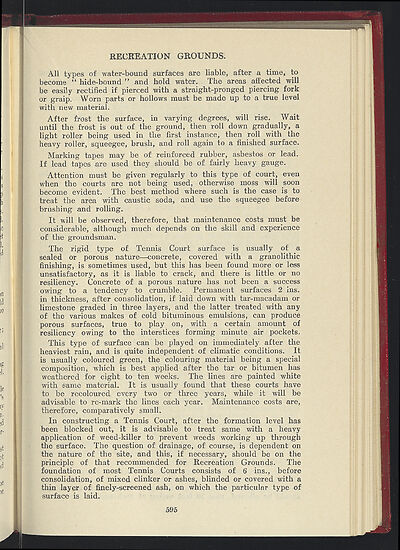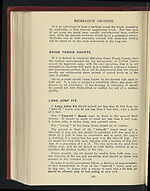1936-37
(621)
Download files
Complete book:
Individual page:
Thumbnail gallery: Grid view | List view

RECREATION GROUNDS
All types of water-bound surfaces are liable, after a time, to
become " hide-bound " and hold water. The areas affected will
be easily rectified if pierced with a straight-pronged piercing fork
or graip. Worn parts or hollows must be made up to a true level
with new material.
After frost the surface, in varying degrees, will rise. Wait
until the frost is out of the ground, then roll down gradually, a
light roller being used in the first instance, then roll with the
heavy roller, squeegee, brush, and roll again to a finished surface.
Marking tapes may be of reinforced rubber, asbestos or lead.
If lead tapes are used they should be of fairly heavy gauge.
Attention must be given regularly to this type of court, even
when the courts are not being used, otherwise moss will soon
become evident. The best method where such is the case is to
treat the area with caustic soda, and use the squeegee before
brushing and rolling.
It will be observed, therefore, that maintenance costs must be
considerable, although much depends on the skill and experience
of the groundsman.
The rigid type of Tennis Court surface is usually of a
sealed or porous nature--concrete, covered with a granolithic
finishing, is sometimes used, but this has been found more or less
unsatisfactory, as it is liable to crack, and there is little or no
resiliency. Concrete of a porous nature has not been a success
owing to a tendency to crumble. Permanent surfaces 2 ins.
in thickness, after consolidation, if laid down with tar-macadam or
limestone graded in three layers, and the latter treated with any
of the various makes of cold bituminous emulsions, can produce
porous surfaces, true to play on, with a certain amount of
resiliency owing to the interstices forming minute air pockets.
This type of surface can ' be played on immediately after the
heaviest rain, and is quite independent of climatic conditions. It
is usually coloured green, the colouring material being a special
composition, which is best applied after the tar or bitumen has
weathered for eight to ten weeks. The lines are painted white
with same material. It is usually found that these courts have
to be recoloured every two or three years, while it will be
advisable to re-mark the lines each year. Maintenance costs are,
therefore, comparatively small.
In constructing a Tennis Court, after the formation level has
been blocked out, it is advisable to treat same with a heavy
application of weed-killer to prevent weeds working up through
the surface. The question of drainage, of course, is dependent on
the nature of the site, and this, if necessary, should be on the
principle of that recommended for Recreation Grounds. The
foundation of most Tennis Courts consists of 6 ins., before
consolidation, of mixed clinker or ashes, blinded or covered with a
thin layer of finely-screened ash, on which the particular type of
surface is laid.
595
All types of water-bound surfaces are liable, after a time, to
become " hide-bound " and hold water. The areas affected will
be easily rectified if pierced with a straight-pronged piercing fork
or graip. Worn parts or hollows must be made up to a true level
with new material.
After frost the surface, in varying degrees, will rise. Wait
until the frost is out of the ground, then roll down gradually, a
light roller being used in the first instance, then roll with the
heavy roller, squeegee, brush, and roll again to a finished surface.
Marking tapes may be of reinforced rubber, asbestos or lead.
If lead tapes are used they should be of fairly heavy gauge.
Attention must be given regularly to this type of court, even
when the courts are not being used, otherwise moss will soon
become evident. The best method where such is the case is to
treat the area with caustic soda, and use the squeegee before
brushing and rolling.
It will be observed, therefore, that maintenance costs must be
considerable, although much depends on the skill and experience
of the groundsman.
The rigid type of Tennis Court surface is usually of a
sealed or porous nature--concrete, covered with a granolithic
finishing, is sometimes used, but this has been found more or less
unsatisfactory, as it is liable to crack, and there is little or no
resiliency. Concrete of a porous nature has not been a success
owing to a tendency to crumble. Permanent surfaces 2 ins.
in thickness, after consolidation, if laid down with tar-macadam or
limestone graded in three layers, and the latter treated with any
of the various makes of cold bituminous emulsions, can produce
porous surfaces, true to play on, with a certain amount of
resiliency owing to the interstices forming minute air pockets.
This type of surface can ' be played on immediately after the
heaviest rain, and is quite independent of climatic conditions. It
is usually coloured green, the colouring material being a special
composition, which is best applied after the tar or bitumen has
weathered for eight to ten weeks. The lines are painted white
with same material. It is usually found that these courts have
to be recoloured every two or three years, while it will be
advisable to re-mark the lines each year. Maintenance costs are,
therefore, comparatively small.
In constructing a Tennis Court, after the formation level has
been blocked out, it is advisable to treat same with a heavy
application of weed-killer to prevent weeds working up through
the surface. The question of drainage, of course, is dependent on
the nature of the site, and this, if necessary, should be on the
principle of that recommended for Recreation Grounds. The
foundation of most Tennis Courts consists of 6 ins., before
consolidation, of mixed clinker or ashes, blinded or covered with a
thin layer of finely-screened ash, on which the particular type of
surface is laid.
595
Set display mode to:
![]() Universal Viewer |
Universal Viewer | ![]() Mirador |
Large image | Transcription
Mirador |
Large image | Transcription
| Games and sports in the army > 1936-37 > (621) |
|---|
| Permanent URL | https://digital.nls.uk/248726011 |
|---|
| Description | 'Games and Sports in the Army' was an annual publication produced by the British War Office between the 1930s and 1960s. This included the Second World War. It outlines the rules and regulations for games and sports played by members of the armed forces. It features names and photographs of team members, and examples of contemporary advertising. |
|---|---|
| Shelfmark | GWB.52 |

